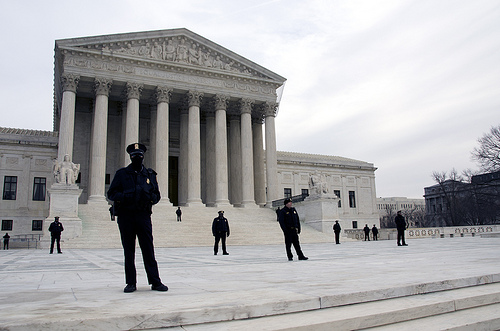The following post was written by NCAC’s summer legal intern, Ryan Gander. Ryan is a current student at Columbia Law School. His interests include philosophy, civil liberties, science fiction, and video games.
The Supreme Court has a troubled relationship with the First Amendment and that’s not even talking about what goes on in the courtroom. Since 1949, federal law has broadly prohibited demonstrations within the Supreme Court building and grounds. That restriction came under fire last Tuesday when Judge Howell of the Federal District Court for the District of Columbia ruled that such a blanket prohibition on demonstration was unreasonable and over-broad and in violation of the First Amendment.
While the Supreme Court has an interest in allowing visitors to enter and exit without being blocked by protesters, creating a First Amendment-free zone is not an acceptable way to accomplish that goal, Judge Howell reasoned.
Two days later, the Supreme Court responded by instituting a building regulation prohibiting, under threat of criminal punishment, “demonstrations, picketing, speech-making, marching, holding vigils or religious services and all other like forms of conduct that involve the communication or expression of views or grievances, engaged in by one or more persons, the conduct of which is reasonably likely to draw a crowd or onlookers” within the Supreme Court building and grounds.
Let’s first clarify exactly what this regulation isn’t, so we can see why it is so problematic:
- First, this is not just a ban on unusually loud protests that would disturb court proceedings. A separate court regulation from 2000 already prohibits “noise disturbances,” so the new regulation can’t claim that benefit.
- Second, this is not just a ban on behavior that would block visitors from entering or exiting the Supreme Court grounds or building. On the contrary, this regulation bans all forms of demonstration, including some—such as vigils—that are extremely unlikely to impede traffic. If the Court wants to prevent protesters from blocking the doors, it could easily impose a regulation saying precisely that (instead of censoring countless peaceful, non-intrusive demonstrations).
- Third and finally, this regulation is not justified by one of its major supposed goals: maintaining the appearance of the Court as a neutral body not swayed by external influence. Allowing protests on Supreme Court grounds wouldn’t make the Court weak or allow it to be controlled by outside influences, but it would demonstrate commitment to the values embodied in the First Amendment. In any case, it’s not clear that appearing neutral is a worthy goal in the first place. After all, Supreme Court justices are human beings and, like it or not, they come with biases and preconceptions just like any other person.
When it comes down to it, there simply isn’t a compelling reason in favor of the Court’s blanket prohibition on demonstration. The new regulation has much the same effect as the 1949 law: it significantly—and unjustifiably—limits the First Amendment rights of anyone who might want to air their grievances to the Supreme Court.


